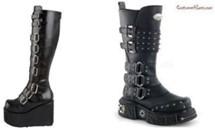Boots
Boots should appear to be of relatively smooth leather with no nap or animal embossing/print.
Boots must be shades of brown for Jedi and black for Sith.
Elastic should be restricted to the back or inside of the boot, and can take up to 25% of the boot’s total area. Any elastic should also match the color of the boot.
Boots should not have visible laces, logos, embellishments, or fringes. Boots should fit closely to the leg without significant ruching,
bunching, or sagging.
Elastic can take up to 25% of the boot’s total area. The back and inside of the leg are preferred for elastic. The outside of the boot may
only have up to 2 in/5.08 cm of elastic.
Boots should reach to a height between the base of the calf (where the muscle begins to curve) and the knee OR be 9 in/25.4 cm in height from top of heel to the top of the shaft. Whichever of these measurements is shorter is the minimum required height for boots.
The shaft should be of similar height at the front and back of the boot, though a difference of less than 1.5 inches (4 cm), similar to traditional riding boots, is permitted. There should not be any significant gaps in the tops of the boots. Fold over top boots like those worn by Mace Windu and Ki Adi Mundi may be acceptable as long as the cuff is even across the boot, though fold-over should be pre-approved by the GCCs to ensure they don’t have a “pirate-like” appearance.
Boots may have up to four straps and four simple buckles, though covering buckles with leather keepers like those seen on Obi-Wan’s boots is recommended. For safety during performances, boots with more than a two- inch (5cm) heel will not be approved. Zippers and zipper-pulls should be the same color as the boot or subdued, and may be painted to reduce visibility. Zippers are only approvable on the inner side and the back of the boot.
Any Spats or half-chaps that are used must appear to be the same color and material of the boot. They have the same requirement as the boot for zippers and elastic. Spats/half-chaps must be secured tightly to the leg and should not flap when worn. Any velcro used to secure spats should not be visible when the boot is worn.
A strap/elastic under the boot is permitted to hold the spat in place so long as the strap is tight to the foot and not a tripping hazard.
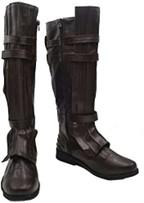 Example of bad spats pulling away from boot |
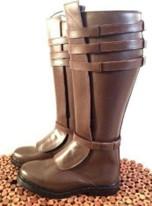 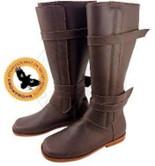 Examples with good spats that are attached properly. |
Approvable Examples
 |
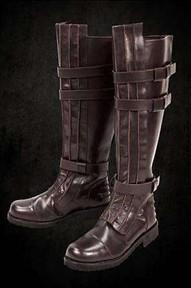 |
Unapprovable Examples
These boots may be tall enough, but they are thin leather and the leather bunches.
These boots have a fold that are not even. These are pirate boots and not Sith or Jedi boots in the style of Ki- Adi Mundi or Mace Windu.
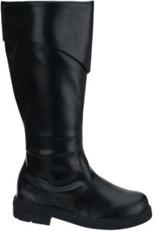
While this style of strap is acceptable on the picture below, in excess it can make for a goth look. The lifts are unsafe for choreography.
Use of Face Character Boots
Several exceptions may be made to the above boot rules in the case of boot styles worn by specific face characters.
Kylo Ren style boots are acceptable for use by both Sith and Jedi in appropriate colors.
Hero Rey boots from The Last Jedi are acceptable for use by both Sith and Jedi in appropriate colors, despite violating the “no visible laces” rule. If these are used, the
laces must match the boots in color. Any boots of this style must have the laces in the back. Laces on the sides or the front will still not be acceptable.
Maul Boots - Sith are allowed to use the same boots Darth Maul uses, or similar boots with the same embossing pattern, provided they also meet other boot guidelines with regards to height requirements, strap limits, and not being too earth-bound.
Qui Gon Boots - Qui Gon style boots are acceptable for use by both Sith and Jedi in appropriate colors and are the one exception to the “No more than 4 straps/buckles” rule for boots.
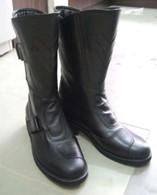 |
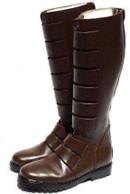 |
Wrapped Boots
Boots are covered with thick layers of wraps which may cover the entire shaft of the boots, and may wrap around the foot as well. The wraps should be made of the list of approvable materials, similar to arm wraps. The color of the wraps should match the boot color or be similar to the major colors of the inner tunic, outer tunic, or upper tabards of the costume. Boot wraps may be colors from secondary colors if they are matching other colors of the costume.
Wraps may go up to the top of the boot, but may not visibly cross over the top seam of the boot (i.e. they must appear to be flush with the top of the boot and not cover any part of the leg).
Short boots such as chelsea boots with added wraps are permitted provided the wraps give the appearance of a full continuous boot that reaches at least to the base of the calf. The wraps must be secured so as not to come undone during a performance.
For boots with heels, wraps may go around the foot of the boot, but must be snug and held securely in place to prevent any tripping hazard. Also, they must not create a grip issue along the underside (sole) of the boot. Velcro, snaps or stitching directly to the boot is recommended to secure wraps, but fastenings must not be visible. Buckles, laces or elastic.
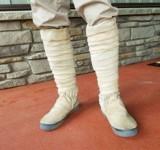 |
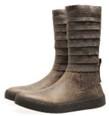 |



